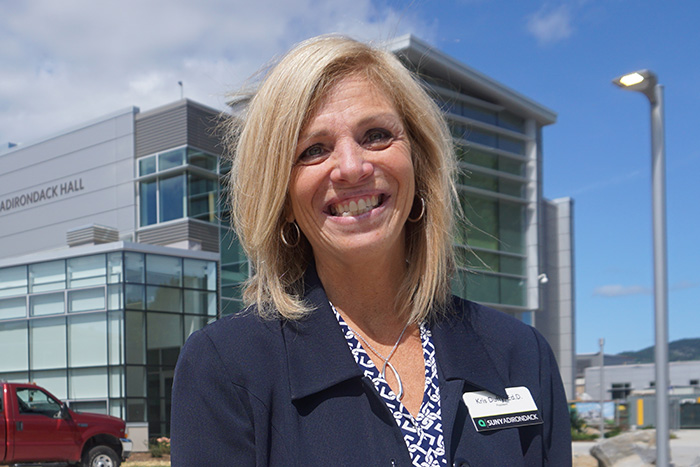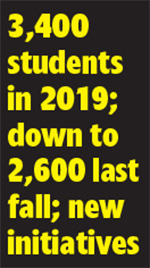By Cathy DeDe, Chronicle Managing Editor
Facing its lowest enrollment numbers since the 1980s, SUNY Adirondack is cutting positions, cutting costs, holding the line on tuition and doubling down on its efforts to serve the community, says its president Kristine Duffy.
“Enrollment was on a decline even before the pandemic,” Dr. Duffy said, “driven by declines in the birth rate in the region, full employment and then of course Covid.”

SUNY Adirondack had about 3,400 students in fall of 2019, pre-pandemic, and was down to about 2,600 last fall.
Dr. Duffy said the decline tracks especially to lower income, PELL Grant-eligible students. “That was the biggest drop, the most vulnerable students. That’s not just Adirondack Community College. Everyone’s in the same position” in the state, she said.
The booming job market is a factor. Community colleges tend to thrive when jobs are scarce, Dr. Duffy said.
“I have no issue with anyone making a living, above minimum wage. Rightly so, a person says, ‘I have a family, I have needs, I can make $20 an hour now.’

“But it can be a short-term solution. In the long run, these wages may not increase. The hard part is, to move up, you need higher education. Once someone steps out of higher education, we find, it’s harder to come back. I’m very concerned that the short-term gain will be a long-term deficit for society.”
Dr. Duffy said, “People have to do what they have to do. It’s a challenge for higher education, not just community colleges.”
She says one priority is to consider, “What might be more accessible?” That includes shorter term workforce-related programs, credentialing courses, “upskill” programs, “maybe not a full degree but training that is meaningful in the workforce.”
Also, she says: “New ways to deliver education” that serve people already working, or with families to take care of.
“One thing we’ve learned from Covid is we can do it remotely, and some of that is really good. The new buzz is ‘HyFlex’” (hybrid flexible) — combining in-person teaching and simultaneous streaming online, recorded for students to access on demand. SUNY Adirondack offered 12 such courses in the fall and expects to continue adding more.
Dr. Duffy said there’s more competition in recent years from online education programs.
“ What we’re trying to do is value added,” she said. “There are tons of opportunities on the Web. That’s great for very motivated, experienced learners. But that’s still not the population we serve. A lot of our students haven’t had the best academic experience. They need the kinds of support that we offer. There’s still a role for us. We are just having to serve a lot of different populations.”
Meanwhile, Dr. Duffy says, “we are looking at, what are new ways to expand enrollment.” These include a “second chance” Pell grant program, offering classes to 22 inmates at Washington Correctional Facility, “helping people regain skills to reenter society.”
SUNY Adirondack has also launched a degree program for 40 students in Doha, the capital of Qatar, on the Persian Gulf. What started pre-pandemic as an effort to attract international students — who pay 150% tuition — went virtual for Covid. “We’re continuing to expand, and looking at other countries,” Dr. Duffy said. “That’s high tech, here. The only barrier is the time difference.”
“All of this programming, it doesn’t come cheap,” Dr. Duffy says. “You have to adapt your staffing. You have to have the technology. It’s an unintended consequence. Our funding needs to keep up with that.”
She said the college typically increases tuition by about 3 percent annually, “but this year, with everything going on, we did not.”
To cut costs, she said, the school eliminated or consolidated seven disciplines last year, including music and several Information Technology programs.
They’ve decreased the faculty from 94 to 82 people. “We’ve made some difficult decisions,” Dr. Duffy said.
She said they released four full-time faculty, held off filling vacated positions and offered retirement incentives for faculty and administrative staff as well.
Adjunct faculty serve as “a release valve,” she said, hired as needed, though she added, “no one wants to not hire someone back.”
At the same time, she said the college has lost employees in what’s called “the great resignation” — affecting both faculty and staff, from nursing instructors to cleaners. That’s draining on the staff and faculty who remain, Dr. Duffy said.
She said, the college’s situation would be much worse, “were it not for about $9 million in federal relief funds,” helping offset costs for Covid testing, protective and cleaning equipment, technology and training as they pivoted to virtual classes, and to cover lost revenue from decreased tuition, closing the Wilton site for a year, and fewer fund-raising opportunities.
A bright spot, Dr. Duffy said, is state funding. Initial word was that the state was considering a 20 percent cut to community colleges.
“That did not pan out, thankfully,” she said. “State aid has remained steady in terms of dollar amounts since 2014,” Dr. Duffy notes. Meanwhile, both Warren and Washington Counties continued their annual 2 percent increase in support this year. “We’re grateful for that.”
Copyright © 2022 Lone Oak Publishing Co., Inc. All Rights Reserved
 Glens Falls Chronicle Serving the Glens Falls/Lake George region; Warren, Washington and northern Saratoga counties since 1980
Glens Falls Chronicle Serving the Glens Falls/Lake George region; Warren, Washington and northern Saratoga counties since 1980


